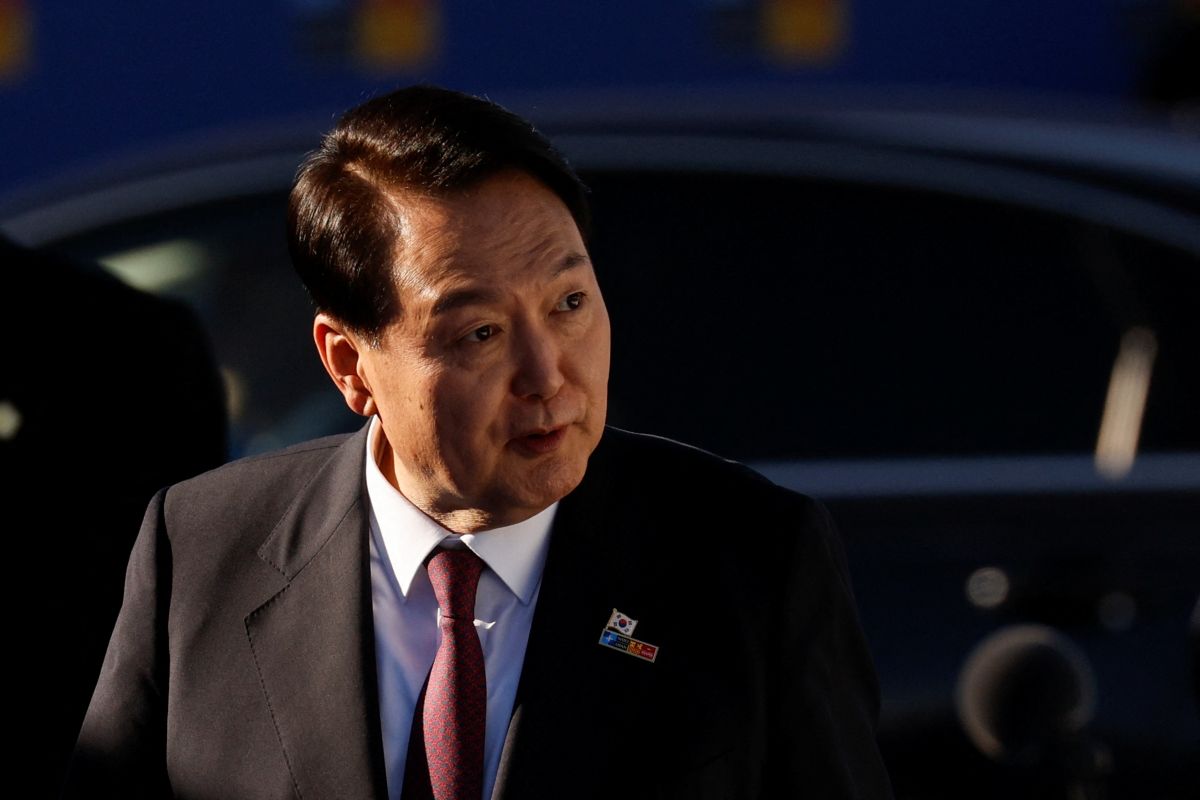South Korea Adopts Indo-Pacific Strategy
Late last year, South Korean President Yoon Suk-yeol’s administration published its “Strategy for a Free, Peaceful, and Prosperous Indo-Pacific”. The document confirms a greater alignment of South Korea’s approach to the region with U.S. policy. However, it does not mean that South Korea is adopting a confrontational stance towards China. This is because the pursuit of economic interests remains the most important in South Korean foreign policy. The inclusive nature of the strategy provides an opportunity to deepen the country’s cooperation with EU countries in the spheres of maritime, cyber, and economic security.
.jpg) Mc2 Michael Jarmiolowski/Us Navy / Zuma Press / Forum
Mc2 Michael Jarmiolowski/Us Navy / Zuma Press / Forum
Despite the growing popularity of the term “Indo-Pacific”, popularised by, among others, Japan and the U.S. administration under Donald Trump, for years South Korea did not use this term (it used “Asia-Pacific” instead). This is because China considers the term confrontational. By avoiding this terminology, the Moon Jae-in government (2017-2022) sought to pursue a policy of relative balance between the U.S., South Korea’s security guarantor, and China, its largest economic partner. With regard to the wider region, South Korea pursued the New Southern Policy, primarily focused on deepening economic ties with Southeast Asian countries and India, which it viewed as complementary to the U.S. strategy of a “free and open Indo-Pacific”.
Since taking office in May 2022, Yoon Suk-yeol has changed rhetoric and announced the preparation of an Indo-Pacific strategy that reflects deepening cooperation with the U.S. and a desire to strengthen South Korea’s global position. An additional motivation for adopting an Indo-Pacific strategy was the publication of analogous documents by other countries besides Japan and the U.S., including Australia, Canada, Czechia, France, Germany, India, the Netherlands, and the UK, and international organisations (ASEAN and the EU).
Objectives and Assumptions
South Korea describes itself as an “Indo-Pacific nation” with the goal of co-creating a “free, peaceful and prosperous” region. Stability in the area is crucial to South Korean interests, especially economically—in 2022, the Indo-Pacific accounted for 78% of South Korea’s exports and 67% of its imports, as well as 66% of the value of foreign direct investment from the country. South Korea therefore considers it necessary to respond to the challenges threatening the stability of the Indo-Pacific, including the arms race (it explicitly mentions the development of the North Korean arsenal), the globalisation crisis, and the political-economic-technological rivalry (without specifying that this contentious relationship is between the U.S. and China).
South Korea intends to co-shape the regional order through cooperation with other states and organisations—especially ASEAN—on the basis of inclusiveness, trust, and reciprocity. South Korea’s strategy therefore does not exclude cooperation with any country, including China, which is identified in the document as a “key partner” for peace and prosperity in the region. The strategy does not mention Russia as a partner, reflecting allied solidarity in condemning it for its aggression against Ukraine. It also does not mention Taiwan, reflecting a reluctance to antagonise China.
Geographically, South Korea intends to widen its activities beyond its close neighbourhood of Northeast Asia and to engage in the other Indo-Pacific sub-regions: Southeast Asia, South Asia, Oceania, and East Africa (the western coasts of the Indian Ocean). It also intends to cooperate with countries outside the Indo-Pacific, including from Europe and Latin America, that are involved in the region.
Means and Methods
The document presents a catalogue of actions and, in the coming months, the relevant ministries are to prepare specific plans for implementing the strategy’s guidelines. South Korea’s activity for a “free” Indo-Pacific is to include, first and foremost, political cooperation with like-minded partners, that is, with countries sharing the values of freedom, the rule of law, and respect of human rights. South Korea emphasises its opposition to violations of international law and cites Russia’s aggression against Ukraine as an example of a blatant violation of the UN Charter that has harmed the security and economy of the Indo-Pacific. The promotion of human rights is also to be a permanent feature of South Korean policy in the region.
In pursuit of a “peaceful” Indo-Pacific, South Korea aims to cooperate in various areas of security (including maritime, cyber, health) with its U.S. ally and key partners, especially Japan (also in a trilateral format with the U.S.), as well as with Australia, India, and European NATO members. Non-proliferation efforts, including the denuclearisation of North Korea, and maritime security are seen as particularly important. South Korea emphasises the need to guarantee freedom of navigation and overflight in the South China Sea and peace and stability in the Taiwan Strait. It also announces further participation in multilateral maritime exercises in the Pacific, such as RIMPAC (led by the U.S.) and Pacific Dragon (with Australia, Japan, Canada, and the U.S.).
The most extensive catalogue of activities is for a “prosperous” Indo-Pacific. South Korea intends to develop regional economic ties by engaging in the Indo-Pacific Economic Framework (IPEF), the Regional Comprehensive Economic Partnership (RCEP), and the Asia-Pacific Economic Cooperation (APEC). It also expresses interest in joining the Comprehensive and Progressive Trans-Pacific Partnership (CPTPP) and readiness to strengthen trilateral formats (e.g., with the U.S. and Japan, and with the U.S. and Australia) to strengthen the resilience of supply chains. It also envisages deepening cooperation, in particular with the U.S., the EU, Canada, and Australia in the area of new technologies such as semiconductors, artificial intelligence, and biotechnology. South Korea has announced further cooperation with the Quad (Australia, India, Japan, the U.S.) in working groups on vaccines, new technologies, and climate initiatives. By offering Indo-Pacific countries solutions to nuclear power and cooperation on electric and hydrogen vehicles, South Korea wants to contribute to climate goals and improve energy security in the region. It also promises to increase development aid to countries in the region, especially for digitalisation, and to intensify people-to-people contacts through even greater use of soft-power tools.
Conclusions and Perspectives
In publishing its Indo-Pacific strategy, South Korea has emphasised its commitment to the alliance with the U.S. and to working with like-minded partners that advocate a regional order based on international law and shared values. So far, the most measurable effect of adopting the strategy has been the intensified dialogue between South Korea and Japan, which serves both to settle historical disputes and to strengthen cooperation in the region. Although the document is a regional strategy, it should be assessed as an expression of the Yoon administration’s foreign policy doctrine. Despite the greater focus on security concerns, the document reaffirms the central importance of economic issues in South Korea’s foreign policy. This applies to both the reasons for engagement in the region and the measures taken. In this respect, the strategy replicates the tenets of the New South Policy.
The biggest challenge in implementing the strategy will be South Korea’s policy towards China. The South Korean document does not explicitly mention China as a challenge and source of problems in the region. This distinguishes it not only from the U.S. National Security Strategy, but also Japan’s security policy documents. Despite its commitment to international law and universal values, South Korea remains reluctant to confront China because of its strong economic interdependence. It is not helped by the regulations of the U.S. Inflation Reduction Act, which discriminates against non-U.S. producers, hitting, among others, the South Korean automotive and electromobility sectors (South Korea, like the EU, is negotiating easing regulations for its entities). Although South Korea will diversify its economic contacts (especially in ASEAN), China will remain a key market for it. This will keep South Korean authorities from reacting more forcefully to possible violations of the status quo by China in the Taiwan Strait or the South China Sea and human rights violations like in Xinjiang.
Declaring its willingness to cooperate with as many partners as possible, South Korea emphasises cooperation with U.S. allies in the region, especially Japan and Australia. The similarity in the assumptions of South Korea’s and the EU’s Indo-Pacific strategies, including a commitment to economic issues and the rules-based international order, offers the possibility of deepening South Korean-EU cooperation in the region in the areas of maritime, cyber, and economic security. This could include participation in joint exercises to respond to natural disasters and combat maritime piracy, the exchange of information on cyber threats (drawing on South Korea’s cooperation with NATO) and coordination in the provision of development assistance to countries in the region. South Korea’s greater interest in the Indo-Pacific will not reduce its involvement in Central Europe, with which it treats economic cooperation and arms deals with Poland as an element of strengthening its global position.





_Easy-Resize.com.jpg)